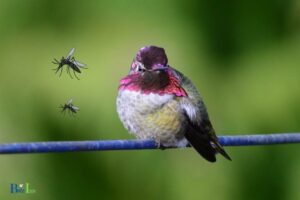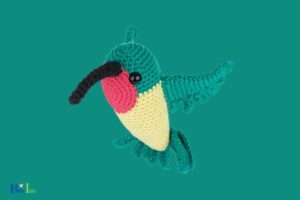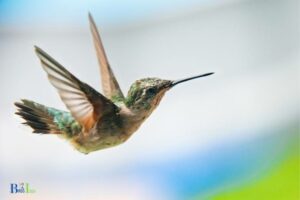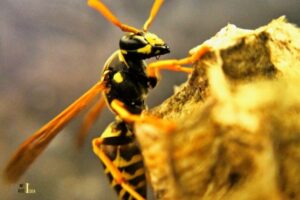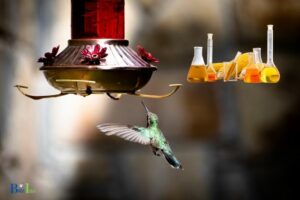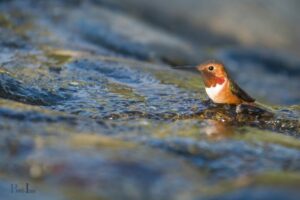How to Make a Hummingbird Habitat? 6 Easy Steps!
To make a hummingbird habitat, you will need to provide food sources, nesting materials, water supply, and protection from predators.
Creating a hummingbird habitat involves the careful selection and placement of plants, bird feeders, water sources, and nesting materials.
By providing the essential needs of hummingbirds, you can attract them to your garden and create a thriving environment for them to flourish.
Nectar-producing flowers are the primary food source for hummingbirds, so choose a variety of native, colorful, and tubular-shaped plants like trumpet vine, bee balm, and salvia.
This will provide a consistent supply of nectar throughout the blooming season. Maintaining a hummingbird feeder with a mixture of 1 part white sugar to 4 parts water will supplement their diet and provide extra energy.
Hummingbirds use natural materials to build their nests, so providing debris such as lichen, moss, and spiderwebs can encourage nesting.
Providing a shallow water source, such as a bird bath, will give the birds a spot to clean their feathers and drink.
Lastly, keep the area relatively protected from predators by ensuring there is ample tree or shrub coverage for the birds to quickly escape to if necessary.
6 Essential Steps to Make a Hummingbird Habitat
| Steps | Description | Items Needed |
|---|---|---|
| 1 | Choose a suitable location | – A spot near flowering plants, -trees, or shrubs |
| 2 | Provide food sources | – Nectar-rich flowers, – Hummingbird feeders, – Sugar-water solution (1 part sugar, 4 parts water) |
| 3 | Provide water | – Birdbath, – Dripping fountain, – Misting system |
| 4 | Provide nesting materials | – Natural materials like leaves, -twigs, moss, and lichen |
| 5 | Provide shelter | – Native trees and shrubs, – Hummingbird houses |
| 6 | Keep the area safe | – Regularly clean feeders, – Keep cats and other predators away, – Avoid using pesticides |
Key Takeaway
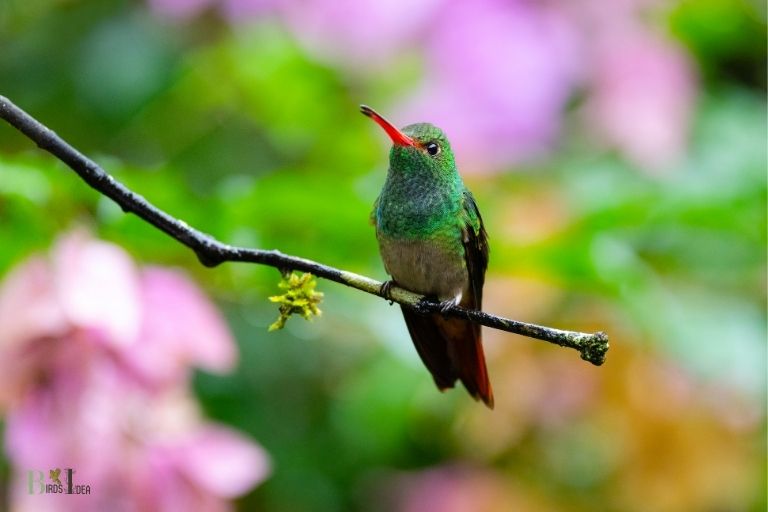
Five Facts About Creating a Hummingbird Habitat
Step 1: Choose The Right Location
Factors To Consider When Selecting A Location For Your Hummingbird Habitat
Hummingbirds are beautiful, delicate creatures that require a specific habitat to thrive. When choosing a location for their habitat, you need to take into account the following factors:
Sunlight And Shade Requirements
Hummingbirds require a balance of sunlight and shade to survive. When selecting a location for their habitat, you should consider the amount of direct sunlight the area receives, as well as the amount of shade.
Ideally, you want to find a spot that gets plenty of morning sun and some afternoon shade. This will ensure that the hummingbirds have a comfortable environment to live in.
Some hummingbird species prefer more shade than others, so it’s essential to research the specific type of hummingbird that you want to attract before choosing a location for their habitat.
Protection From Wind, Predators, And Other Threats
Hummingbirds are tiny creatures that are easily affected by strong winds. When choosing a location for their habitat, it’s important to find a spot that is sheltered from strong winds, so they can feed and rest without any disruptions.
In addition to wind, you also need to protect your hummingbirds from predators such as cats, snakes, and birds of prey. Try to find a location that is away from these potential threats.
Ideal Locations For Nesting
Hummingbirds build small, delicate nests in high, sheltered locations. When choosing a location for their habitat, you want to find a spot that is high off the ground and protected from the elements.
This could be a tall tree, a sheltered porch, or a trellis. It’s also important to make sure that the location is easily accessible for the hummingbirds to build their nests.
Avoid areas that are too difficult to navigate, as this could deter them from staying in the habitat.
Now that you know the factors to consider when choosing a location for your hummingbird habitat, you can create a comfortable and safe environment for these delicate creatures.
Happy hummingbird watching!
Step 2: Create A Hummingbird-Friendly Environment
Creating A Hummingbird-Friendly Environment
In the previous step, we discussed how to select the perfect location for your hummingbird habitat. This step focuses on creating an environment that hummingbirds will enjoy and thrive in.
Here are some key aspects to consider:
Selecting The Right Plants For Your Habitat:
Hummingbirds love trumpet-shaped flowers that are red, orange, or pink, and tubular with flared ends.
Here are some plants to consider:
- Bee balm: Also known as monarda, bee balm bears bright-colored flowers that attract hummingbirds and bees alike.
- Cardinal flower: One of the most striking red flowers, cardinal flower is irresistible to hummingbirds.
- Salvia: The showy spikes of salvia are magnets for hummingbirds, and the plant is available in many colors.
- Shrimp plant: The unusual-looking flowers of shrimp plant are a treat for hummingbirds.
- Fuchsia: The pendant, bell-shaped flowers of fuchsia are commonly seen in hummingbird gardens.
Providing Food And Water Sources For Hummingbirds:
Hummingbirds need more than just nectar from flowers to survive. They require protein-rich insects such as gnats and fruit flies to supplement their diet. You can attract insects by providing suitable habitats, such as compost piles and rotting logs.
To provide water, add a water source such as a birdbath, fountain, or dripper to your habitat. Make sure to keep it clean and fresh, and change the water daily in hot weather.
Creating A Safe And Enjoyable Environment For Hummingbirds:
Hummingbirds are vulnerable to predators such as cats, so make sure to keep your habitat free of hazards. Avoid using insecticides, as they can harm both hummingbirds and their insect prey.
To create a more enjoyable environment for hummingbirds, you can add perches such as small branches to your habitat. These perches give hummingbirds a place to rest and observe their surroundings.
Recommendations For Maintaining A Healthy And Vibrant Hummingbird Habitat:
To keep your hummingbird habitat healthy and vibrant, follow these tips:
- Prune back overgrown plants to help improve air circulation and prevent the spread of disease.
- Clean feeders and water sources regularly to prevent the build-up of mold and bacteria.
- Remove any dead plants or plant debris to reduce the risk of disease and pests.
- Monitor your hummingbird population and adjust your habitat as needed. If you notice fewer hummingbirds visiting, try adding more plants or increasing the number of feeders.
Following these recommendations will help you maintain a healthy and vibrant hummingbird habitat that will bring joy and wonder to your backyard.
Step 3: Building And Installing Feeders
Different Types Of Hummingbird Feeders
Choosing the right feeder is crucial for attracting hummingbirds to your habitat. There are different types of feeders available, including glass, plastic, and ceramic.
Here are some key points to consider when selecting a feeder:
- Opt for a feeder with bright colors, as hummingbirds are attracted to red and orange hues.
- Choose a feeder with a built-in bee guard to protect the nectar from bees and flying insects.
- Make sure the feeder has multiple feeding ports and perches to accommodate multiple birds.
- Look for easy-to-disassemble feeders for cleaning purposes.
- Avoid feeders with yellow flower design, as they tend to attract bees and wasps instead of hummingbirds.
Constructing A Homemade Feeder
If you’re feeling crafty, you can construct a diy hummingbird feeder with simple materials found at home.
Here are some ideas:
- Use a plastic bottle, cut two holes near the top, insert a straw through each hole for birds to feed, and seal the bottom with a sugary solution.
- Drill small holes in a plastic container lid, insert wooden dowels, and fill the container with nectar.
- Use a small glass bottle with a cork and attach a plastic flower at the top, fill the bottle with nectar, and hang it outside.
Ideas For Feeder Placement And Arrangement
Where you place and arrange your feeders can make all the difference in attracting hummingbirds.
Here are some tips:
- Hang your feeders in a shaded area, as direct sunlight can spoil the nectar.
- Keep the feeders away from predators, such as cats, by placing them in areas that aren’t easily accessible.
- Arrange the feeders at varying heights and distances from each other to accommodate multiple birds and reduce territorial disputes.
- Place feeders near habitat elements such as flowers, shrubs, or trees to offer natural food for hummingbirds.
- Clean up any spilled nectar or seeds on the ground regularly to avoid attracting unwanted pests.
Maintaining And Cleaning Your Feeders For Optimal Hummingbird Health
To ensure optimal health for the hummingbirds that visit your habitat, it’s essential to clean and maintain your feeders regularly.
Here are some key points to consider:
- Change the nectar solution every 2-3 days, even if it’s not entirely gone, to prevent spoilage.
- Clean the feeders with hot, soapy water every time you change the nectar.
- Make a disinfectant solution with one part white vinegar and four parts water and soak the feeder in it for 15 minutes once a month.
- Rinse the feeder thoroughly with hot water after cleaning.
- Avoid using dish soap, bleach, or any harsh chemicals that can harm birds.
Follow these guidelines, and you’ll soon have a thriving hummingbird habitat!
Step 4: Enhancing The Habitat With Accessories
Enhancing The Habitat With Accessories
Creating a hummingbird habitat doesn’t just stop at planting the right flowers and providing enough food sources for these charming creatures.
To attract more hummingbirds to your garden, you can enhance your habitat with accessories that will provide these birds with the perfect environment to thrive.
By adding birdhouses and nesting materials, integrating water features and bird baths, and luring more hummingbirds with garden decorations and accessories, you can create a hummingbird habitat that will offer food, shelter, and safety for these wonderful creatures.
Adding Birdhouses And Nesting Materials To Your Habitat
Adding birdhouses to your habitat can provide hummingbirds with a safe place to nest.
Here are some key points to keep in mind when adding birdhouses and nesting materials to your garden:
- Choose a birdhouse that is specifically designed for hummingbirds, with the right size and shape that suits their needs.
- Place the birdhouse in a sheltered location, but make sure it’s still visible for the hummingbirds.
- Add nesting materials such as moss, soft plant fibers, or spider webs inside the birdhouse to make it more attractive and comfortable for the birds.
Integrating Water Features And Bird Baths
Hummingbirds not only enjoy nectar-rich flowers but also love to bathe. Integrating a water feature or bird bath into your hummingbird habitat can provide these birds with clean water for drinking and bathing.
Here are some key points to keep in mind when adding water features:
- Choose a water feature or bird bath that’s shallow enough for hummingbirds to drink and bathe in safely.
- Keep the water clean and free from bacteria and algae.
- Place the water feature or bird bath near flowering plants to attract more hummingbirds, but make sure it’s not too close to the birdhouse to avoid disturbance.
Lure More Hummingbirds With Garden Decorations And Accessories
Garden decorations and accessories can be a great way to attract more hummingbirds to your habitat.
Here are some key points to keep in mind when adding decorations and accessories:
- Choose vibrant colors such as red, orange, pink or purple, as hummingbirds are attracted to bright and striking shades.
- Add wind chimes or bells to your garden to add extra stimulation for the birds to explore the area.
- Use reflective materials like mirrors and shiny surfaces to reflect the sunlight and create an attractive foraging ground for the hummingbirds.
Recommended Tools And Materials For Enhancing Your Hummingbird Habitat
Creating a hummingbird habitat that’s enticing and safe for these birds requires the use of the right tools and materials.
Here are some of the recommended tools and materials:
- Hummingbird feeders – choose a feeder that’s easy to clean and has enough ports to accommodate several birds at once.
- Birdhouses – make sure to use birdhouses that are specially designed for hummingbirds, with the right size and shape for their specific needs.
- Nesting materials – use soft plant fibers, moss, or spider webs to line the birdhouse and provide a comfortable nesting environment for the birds.
- Water features and bird baths – choose features that are shallow and easy to maintain, with clean and fresh water.
- Decorations and accessories – use vibrant colors, reflective materials, and wind chimes to attract hummingbirds and provide extra stimulation.
By following these tips, you can create a hummingbird habitat that’s inviting, comfortable, and safe for these beautiful birds to thrive and flourish.
FAQ On Hummingbird Habitat
What Kind Of Plants Do Hummingbirds Like?
How Do I Create A Hummingbird-Friendly Environment?
What Should I Feed Hummingbirds?
How Do I Keep Ants Away From Hummingbird Feeders?
Where Should I Place My Hummingbird Feeder?
Conclusion
Now that you know how to make a hummingbird habitat, you can enjoy the sight of these beautiful birds in your own backyard. By following the tips discussed in this post, you can create a safe and comfortable environment for hummingbirds to thrive.
Remember to include a diverse array of flowers and plants, provide fresh water, and keep predators at bay. Creating a hummingbird habitat is not only beneficial for the birds but can also be a rewarding experience for you as a nature lover.
So, get started on building your hummingbird-friendly garden today and enjoy the beauty and grace of these tiny winged friends. With a little effort and care, you can transform your backyard into a lively and vibrant space that welcomes hummingbirds and other wildlife.

